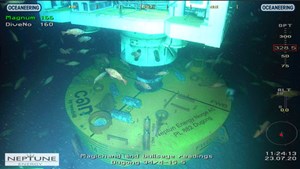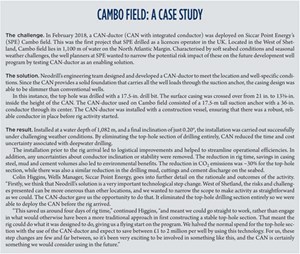Developing pre-rig solutions that are greener, safer and more efficient
There is an increased focus in the oil and gas sector to look further afield to opportunities presented in deepwater locations. Because of this, finding cost-efficient solutions and overcoming the associated challenges that arise below 1,000 ft will be vital for the success of new activity.
All those currently—and those considering—operating in deepwater fields will have an awareness of the general challenges that are presented at such depths. From considerations relating to vast increases in pressure, to the potential for increased drilling time and days spent offshore, there are several hurdles that follow when operating in what are often challenging well environments. In addition, suitable solutions also must support the industry drive to reduce emissions by offering a more carbon-efficient approach.
At Neodrill, our focus has always been to use pre-rig well construction to create greener, safer and cost-efficient solutions for exploration and production wells. Our products, which are all fully commercialized since 2006, have been developed by highly qualified engineers with extensive experience in field operations across the globe, including those in deepwater areas. This background, knowledge and expertise goes a long way in making these products reliable, cost-efficient, and ensuring that there is a seamless integration with the customer’s workflow. This, in turn, helps to provide the highest possible return on investment.
OUR APPROACH
The successful approach we’ve taken is simple. Yet, to fully understand it, it’s best to start at the beginning. We start with a CAN (Conductor Anchor Node), which is a suction anchor with the conductor housing, plus one length of conductor integrated, Fig. 1. The suction anchor pushes the conductor pipe into the seabed, providing structural support for the well while replacing the conventional long conductor used for the top hole.
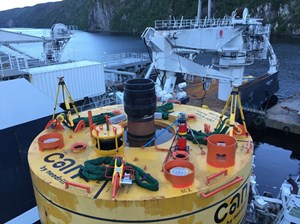
It’s this technology that has been the foundation for our continually ongoing innovations within the energy sector. We’ve adopted what we refer to as our very own “lego brick” style approach, providing the platform to find solutions to challenges in the pre-rig well construction process.
Given the ESG concerns of operators today, the approach is three-pronged: our products are greener, smarter and safer. CAN technology reduces the environmental impact, saves rig time, removes the handling of large and heavy conductor tubulars and protects the wellhead from fatigue-related issues.
Using this modular innovation methodology, we have delivered improved solutions, and are also enabling the next era of subsea solutions.
THE CAN-DUCTOR
Our CAN-ductor is the perfect example to illustrate how we are redefining the standard in structural wellhead foundations, Fig. 2. With the CAN as the starting point, the CAN-ductor is the next evolution. By using the load capacity of the CAN, we have been able to shorten the length of the conductor to one joint. This one joint, together with the housing, is then integrated within the body of our CAN in the workshop, Fig. 3.
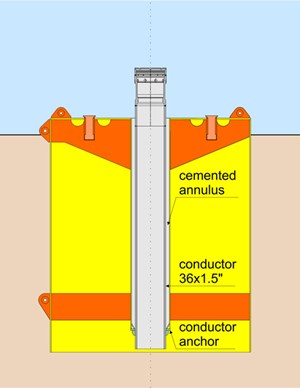
This solution was developed to facilitate installation of the top-hole with light vessels, as the CAN-ductor is installed as one unit by a vessel ahead of rig arrival. This removes the conductor hole drilling, conductor running and cementing operations from the rig schedule and offers simplified P&A operations while mitigating a series of common top-hole related risks.
These CAN solutions can be manufactured at local yards around the world, and once complete, they are ready to be installed by a vessel, at the chosen drill site ahead of the rig arrival. Unlike traditional wellhead systems that leave operators with uncertainties up to and after installation, the CAN-ductor provides a reliable well foundation with verified load capacity, and pre-installed top cement to safeguard quality and integrity. With this patented device, operators can help mitigate against common risks with conventional conductor installation. We strongly believe that it is helping to revolutionise the industry.
The conductor can be installed with light vessels and, therefore, the well support is no longer at the mercy of soil properties surrounding the well. This makes it a reliable solution for all soil conditions, including where it’s required on soft seabeds.
BENEFITS OF THE CAN-DUCTOR
The CAN-ductor can be used in both exploration and production wells, providing specific benefits for each. For exploration wells, it is a rental product and can be recovered following completion of the drilling operation. It is only necessary to cut the surface casing, making P&A operations far more efficient than conventional methods. For production wells, the CAN technology offers the same benefits as for the exploration wells. In addition, it enables pre-mounting of SPS equipment, as well as potential for accelerated production by conducting SURF activities prior to drilling of the well.
Building CAN solutions onshore enables us to ensure quality and pre-complete tasks that would traditionally be done at higher costs offshore. It also helps to save time, as deployment is undertaken independent of the rig schedule. The CAN-ductor is installed from a vessel ahead of rig arrival, and installation quality is verified before rig operations begin offshore. The CAN solution has a guaranteed inclination of < 1o, with an average of 0.40o to date.
Importantly, this also delivers improved HSE by removing the hands-on conductor installation from the rig schedule and subsequently reducing the number of heavy lifts offshore. This reduces the risk associated with open-water rig operations, making risk management as low as reasonably possible (ALARP). This, in combination with its ability to be executed with simplified logistics, makes it the best available practice for top-hole construction.
It also helps to simplify P&A operations. Use of the device mitigates a series of common top-hole risks, as the rig only needs to cut the surface casing before leaving the location. A light vessel is then able to retrieve the CAN, saving on average between two and four days, compared to traditional methods. The operator is also given a verified load capacity, as this is calculated onshore and verified during installation to ensure quality and integrity.
We are working to redefine the standard in subsea well construction for all fields. Our recent activities have helped to illustrate an ability to overcome the associated challenges presented by complex and challenging deepwater environments.
CAMBO FIELD
Since 2006, we have carried out projects across the globe, in water depths ranging from 100 to 1,500 m. While the CAN-ductor has a capacity to facilitate shallow kick-offs, having been field-proven in the Barents Sea for a horizontal well with top reservoir at 250 m below mudline, it’s also suitable for deepwater projects. One of our deepwater projects was the installation of a CAN-ductor on Siccar Point Energy’s Cambo appraisal well in 2018, offshore the UK’s Shetland Islands, Fig. 4.
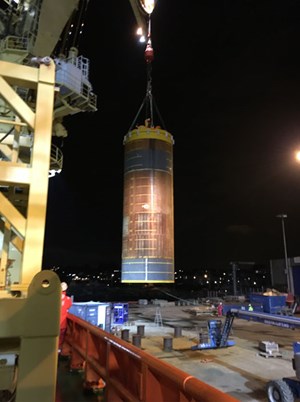
In the West of Shetland, the risks and challenges of activity are considerable. The weather in the area means that from October to March, operators may have to consider substantial downtime during drilling activities, due to harsh weather conditions. As it is possible to install the CAN ahead of rig arrival, any CAN unit potentially to be deployed for a future field development could be installed in favorable weather conditions during the summer months, when the weather is much better, compared to the winter months.
The CAN unit installed in 2018 was located in 1,100 m of water on the North Atlantic Margin, and the field is characterized by having soft seabed conditions. The CAN-ductor used on Cambo field consisted of a 17.5-m suction anchor with an integrated 36-in. conductor through the center. At 17.5 m high and 6 m in diameter, it was the largest CAN-ductor designed and installed to date.
As with all CAN solutions, the Cambo CAN-ductor was installed with a construction vessel. The installation took 17 hr, and the final inclination of 0.2o was verified to ensure that there was a vertical and robust conductor installation in place prior to the arrival of the rig. With a successful installation completed during February 2018, the well was then drilled during the same spring by the West Hercules rig.
CONSTANT INNOVATION FOR DEEPWATER REQUIREMENTS
Innovation sits at our heart, and we are always looking forward to what’s coming up on the horizon, ensuring our projects meet the demands of the upstream sector.
For instance, the CAN technology is especially suited for satellite developments. The CAN can be used as a foundation for production equipment or protection structures over the satellite well. After the CAN units are installed, a metrology of the field layout can be taken to determine the flowline lengths and routings.
The technology also saves more rig time by integrating production systems onto the CAN in the workshop, since the conductor is an integral part of the CAN-ductor. For example, a permanent guide base protection structure (if relevant) can be mounted onto the CAN and installed together by the construction vessel prior to rig arrival.
For us, further development of the technology may also involve moving more of the production equipment over to the CAN foundation. Flow base and pull-in anchors for flowlines and umbilicals may be placed on the CAN structure, which also includes the associated piping and isolation valves.
This will allow for higher flexibility of field layouts and, in some cases, avoid the need for well cluster manifolds by simply connecting the wells along the pipelines. Combining two CAN-ductor units in one structure is a natural development of this, to reduce the number of flowlines and connection points. This has been done at Equinor’s Bauge field on the Norwegian Continental Shelf.
A GREENER OUTLOOK
The focus on innovation in pre-rig well construction has always been paired with a focus to create greener, cost-efficient solutions for exploration and production wells.
When compared to traditional methods, all of our proprietary CAN technology and wider subsea solutions reduce the CO2 footprint of top-hole construction. We believe that this makes it the best choice available for reducing emissions in top-hole well construction.
Direct, measurable results can be seen. For example, by reducing rig time by two to four days, it decreases the combustion of fossil fuels during operations. As noted in the Cambo field case study (see sidebar story), it also reduces the need for—and increased production of—steel in well casings, all while eliminating top-hole cuttings and the need for their disposal, as well as eliminating the cement job for the conductor.
To quantify these results, independent studies have been carried out looking at a range of environmental factors. We are able to say that top hole construction undertaken with the CAN-ductor offers a 21%-to-44% lower environmental impact compared to that of a conventionally drilled top hole.
LOOKING TO THE FUTURE
Over the last few years, we have observed a real tipping point in the industry, with a tangible shift away from some of the more traditional technologies. The adoption of digital, remote and greener technologies is accelerating, and this should be lauded. We want to support and accelerate the rate of change to newer, greener technologies and believe our CAN technology offers a perfect platform for this, Fig. 5.
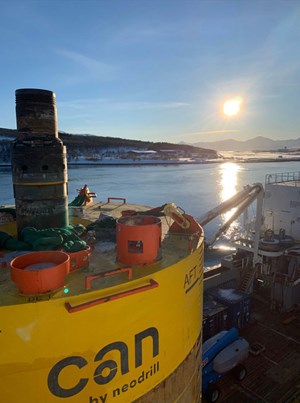
Environmental impact is a concern that will only grow in importance, and we are very proud to be playing a role in helping the industry transition to cleaner, safer and greener processes. Our technology has demonstrated its adaptability under challenging conditions, and we look forward to working with clients to further improve efficiencies and reduce their environmental impact, as well as improving safety and operational efficiencies.
- Advancing offshore decarbonization through electrification of FPSOs (March 2024)
- Subsea technology- Corrosion monitoring: From failure to success (February 2024)
- Driving MPD adoption with performance-enhancing technologies (January 2024)
- Digital transformation: A breakthrough year for digitalization in the offshore sector (January 2024)
- Offshore technology: Platform design: Is the next generation of offshore platforms changing offshore energy? (December 2023)
- 2024: A policy crossroads for American offshore energy (December 2023)
- Applying ultra-deep LWD resistivity technology successfully in a SAGD operation (May 2019)
- Adoption of wireless intelligent completions advances (May 2019)
- Majors double down as takeaway crunch eases (April 2019)
- What’s new in well logging and formation evaluation (April 2019)
- Qualification of a 20,000-psi subsea BOP: A collaborative approach (February 2019)
- ConocoPhillips’ Greg Leveille sees rapid trajectory of technical advancement continuing (February 2019)

